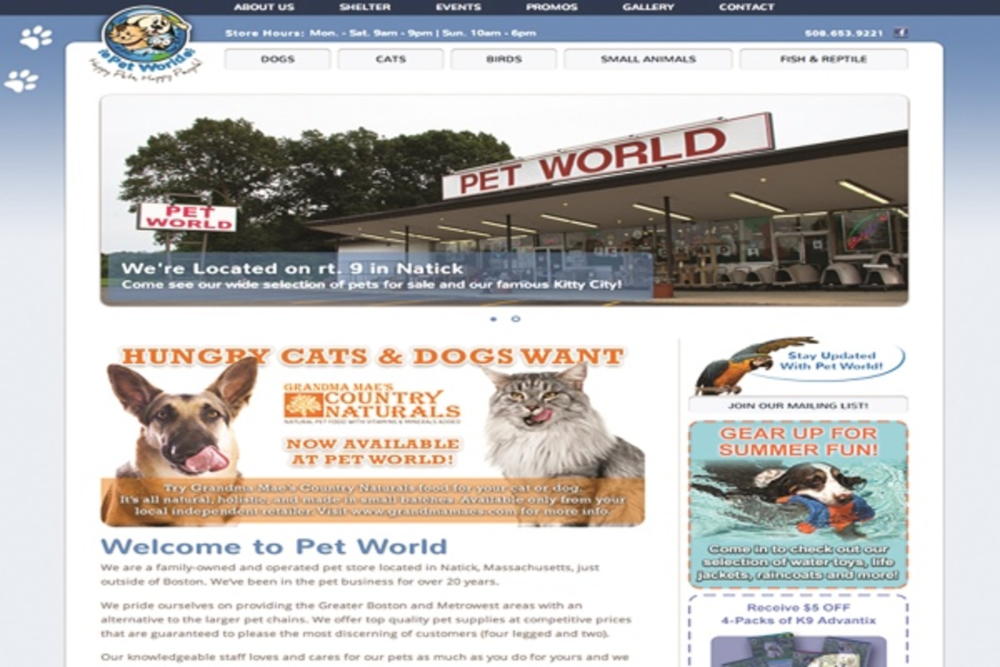The retail industry is a dog-eat-dog world, and no business understands this more than family owned and operated pet store Pet World in Natick, MA. With pet chain Petco right in its back yard, the small business strives to differentiate itself through in-store experiences and specialty brands and products. However, Pet World’s rudimentary website didn’t accurately depict the brand’s personality or offerings and, therefore, didn’t drive traffic to the store. Aiming to make its website a better representation of its in-store experience, Pet World engaged digital marketing agency Champ Internet Solutions and developed a multichannel marketing strategy that gave its business new legs.
Teaching an old dog new tricks
Pet World first started working with Champ five years ago. However, fixing the website’s broken links, dead-end pages, and dated feel weren’t the only problems that the digital marketing agency faced. It also had to overcome a unique branding challenge.
When Pet World first set up shop more than 20 years ago, the retailer adopted an old Carpet World sign atop the store. “We just came up with the name Pet World by painting out the C, A, R,” says Doug Alton Sr., owner of Pet World. If the brand were to change the sign, it would have to adhere to new regulations. So in the first phase of the redesign, Champ had to balance giving Pet World’s website a more modern feel while still aligning the branding with the sign so that it was recognizable, says Seth Worby, president of Champ. As a result, the agency placed a photo of the store featuring the sign prominently on the website (as one of two items in a large rotator), and created a new logo that it incorporated in-store (such as on the welcome mat), online, and in the retailer’s communications.
In addition to fixing the website’s tech issues and the store’s branding, Champ extended Pet World’s online content and the flow associated with it during the second phase of the redesign, which it launched eight months ago. Previously, the site had pages for each type of pet: cats, dogs, etc. Each of those pages featured a bulleted list of the product categories that it sells for that pet, such as toys or grooming essentials. Instead of providing the same navigation in version two, Pet World deepened it by giving each product category its own page. So if customers click on the dog page, and then click on the “Toys and Treats” category, for instance, they would be taken to a page listing seven subcategories of toys and treats, each with a description of what Pet World sells in that subcategory. Each page features a hero image of that display area of the store; certain pages, such as the dog food page, also include a full list of the brands that Pet World sells in that category. Including more keywords and brand names boosts the retailer’s SEO, Worby explains, and makes the site a better resource for customers. Both of these benefits, he adds, lead to the ultimate goal of driving new and existing customers to the store.
Since redesigning the site, Pet World has seen a 37% increase in on-site visitor time and a 10% increase in page views per visit.
“I’d compare [the old site to] a Model A Ford,” Pet World’s Alton says. “It would run, but it didn’t go too well, and it would break down all the time. No one really looked at it much. [As for] the new site, I’d say we’re getting up to a BMW. There’s no comparison.”
Using data to send emails to birds of a feather
Once Pet World lures customers to its store, it wants to ensure that they return. So the retailer relies on email to keep customers up to date on what’s happening in-store.
About two years ago the retailer installed an iPad kiosk in-store that customers can use to opt in to receiving Pet World’s newsletter. The opt-in form asks for a customer’s name, email address, ZIP Code, preferred brands, and pet type. This information is housed in Pet World’s CRM system, which Champ also runs. The retailer then uses this data to send subscribers a monthly newsletter, as well as targeted weekly messages about events and products related to their stated preferences. For instance, Pet World may notify specific customers of an upcoming dog-training event in Boston based on the data provided, Worby explains. “We don’t send dog-food coupons to cat owners if we can avoid it,” he says.
Today, Pet World has grown its newsletter base from about 500 to more than 3,000 subscribers.
In addition to educating customers, Pet World uses email to drive traffic to its website and Facebook page. The company uses Facebook to post digital coupons and funny pictures of animals, as well as to provide customers with information about upcoming events and new products.
Helping its feline friends
Not only does Pet World rely on multichannel to grow its business, but it also uses the approach to help its four-legged friends, specifically cats. The retailer houses cats from the nearby animal shelter Stray Pets in Need and created the Kitty City Cat Cam, which allows Pet World’s website visitors to view adoptable cats via live stream during certain hours. Besides prompting cat adoptions, the Cat Cam drives people to Pet World’s website and store. Pet World is looking to expand the Cat Cam experience, Worby says, by offering vendors sponsor opportunities, creating cat bios and highlight reels, and developing a social community that allows owners to upload images and adoption stories—just another way to make its multichannel marketing the cat’s meow.








